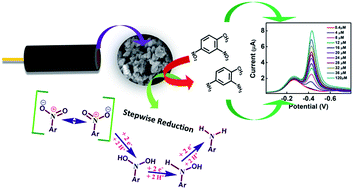A flower-like ZnO–Ag2O nanocomposite for label and mediator free direct sensing of dinitrotoluene†
Abstract
2,4-Dinitrotoluene (2,4-DNT) is a nitro aromatic compound used as a raw material for trinitrotoluene (TNT) explosive synthesis along with several other industrial applications. Easy, rapid, cost-effective, and selective detection of 2,4-DNT is becoming essential due to its hepato carcinogenic nature and presence in surface as well as ground water as a contaminant. Keeping this in view, this research, for the first-time, reports the synthesis of novel ZnO–Ag2O composite nanoflowers on a gold (Au) substrate, to fabricate an electrochemical sensor for label-free, direct sensing of 2,4-DNT selectively. The proposed ZnO–Ag2O/Au sensor exhibits a sensitivity of 5 μA μM−1 cm−2 with a low limit of detection (LOD) of 13 nM, in a linear dynamic range (LDR) of 0.4 μM to 40 μM. The sensor showed reasonably high re-usability and reproducibility, with reliable results for laboratory and real-world samples.



 Please wait while we load your content...
Please wait while we load your content...